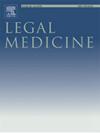Anthropological and forensic significance of facial soft tissue thickness in Montenegrin population
IF 1.4
4区 医学
Q3 MEDICINE, LEGAL
引用次数: 0
Abstract
A lack of soft tissue leads to difficulties in facial reconstruction and further identification in the absence of DNA (deoxyribonucleic acid), finger print and dental data. If these data are not available, then identification based on facial soft tissue thickness (FSTT) is the next reliable method. There is no data in the literature about facial soft tissue thickness in Montenegrin population. Once the measurement is performed, a software algorithm based on the multidetector computerized tomography (MDCT) imaged bone structures and use of FSTT would be able to provide a useful picture of the face for identification purposes. This prospective research was performed by MDCT head examinations of 83 adults aged 18–85, living in Montenegro. The FSTT was measured at eight central points (glabella (GL), nasion (NA), rhinion (RHI), mid-philtrum (MID), upper lip (UL), lower lip (LL), mental eminence (ME), and the point beneath the chin (BC)), and five bilateral points (frontal tubers (FT), supraorbital (SO), external orbital marginal point (EX), zygomatic arch (ZY), and middle masseter (MST)). It was observed that the points RHI, MID, UL, LL, ME, FT, SO and MST are thicker in men compared to women. With an increase in BMI, FSTT in the central points also increases, as well as bilaterally at the ZY, FT, SO and MST points. With aging, there is an increase of the thickness of the FSTT at the RHI and bilaterally at the EX and ZY, while at the MID, LL and MST, the thickness decreases with aging, in both sexes.
黑山人面部软组织厚度的人类学和法医学意义
在没有 DNA(脱氧核糖核酸)、指纹和牙齿数据的情况下,软组织的缺乏会导致面部重建和进一步鉴定的困难。如果没有这些数据,那么根据面部软组织厚度(FSTT)进行鉴定是下一个可靠的方法。文献中没有关于黑山人口面部软组织厚度的数据。一旦进行了测量,基于多载体计算机断层扫描(MDCT)成像骨骼结构的软件算法和 FSTT 的使用将能够为识别目的提供有用的面部图像。这项前瞻性研究是通过对居住在黑山的 83 名年龄在 18-85 岁之间的成年人进行 MDCT 头部检查来完成的。FSTT 在八个中心点(颧骨 (GL)、鼻翼 (NA)、鼻小柱 (RHI)、咽中线 (MID)、上唇 (UL)、下唇 (LL)、精神突起 (ME) 和颏下点 (BC))和五个双侧点(额管 (FT)、眶上 (SO)、眶外缘点 (EX)、颧弓 (ZY) 和中颌肌 (MST))进行测量。观察发现,与女性相比,男性的 RHI、MID、UL、LL、ME、FT、SO 和 MST 点较厚。随着体重指数的增加,中心点的 FSTT 也会增加,双侧 ZY、FT、SO 和 MST 点的 FSTT 也会增加。随着年龄的增长,RHI 点以及 EX 和 ZY 双侧的 FSTT 厚度增加,而 MID、LL 和 MST 点的厚度则随着年龄的增长而减少,男女均是如此。
本文章由计算机程序翻译,如有差异,请以英文原文为准。
求助全文
约1分钟内获得全文
求助全文
来源期刊

Legal Medicine
Nursing-Issues, Ethics and Legal Aspects
CiteScore
2.80
自引率
6.70%
发文量
119
审稿时长
7.9 weeks
期刊介绍:
Legal Medicine provides an international forum for the publication of original articles, reviews and correspondence on subjects that cover practical and theoretical areas of interest relating to the wide range of legal medicine.
Subjects covered include forensic pathology, toxicology, odontology, anthropology, criminalistics, immunochemistry, hemogenetics and forensic aspects of biological science with emphasis on DNA analysis and molecular biology. Submissions dealing with medicolegal problems such as malpractice, insurance, child abuse or ethics in medical practice are also acceptable.
 求助内容:
求助内容: 应助结果提醒方式:
应助结果提醒方式:


